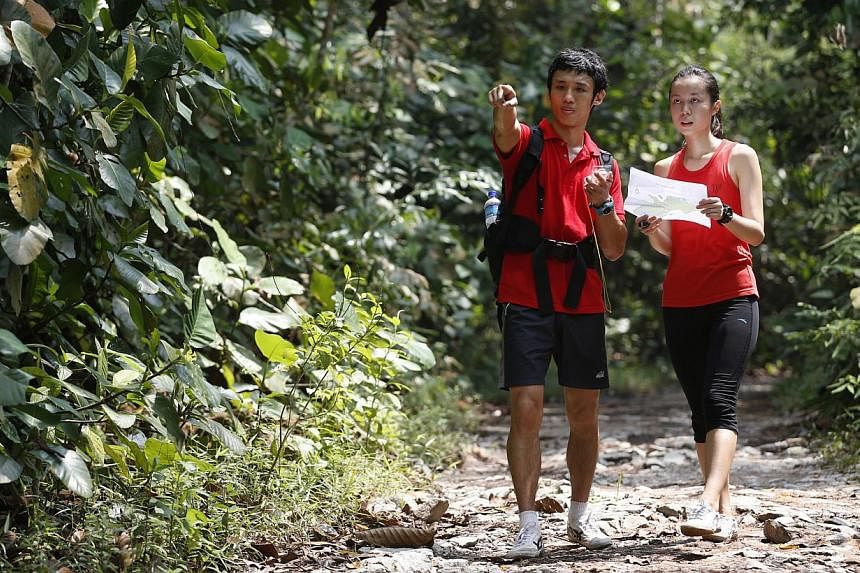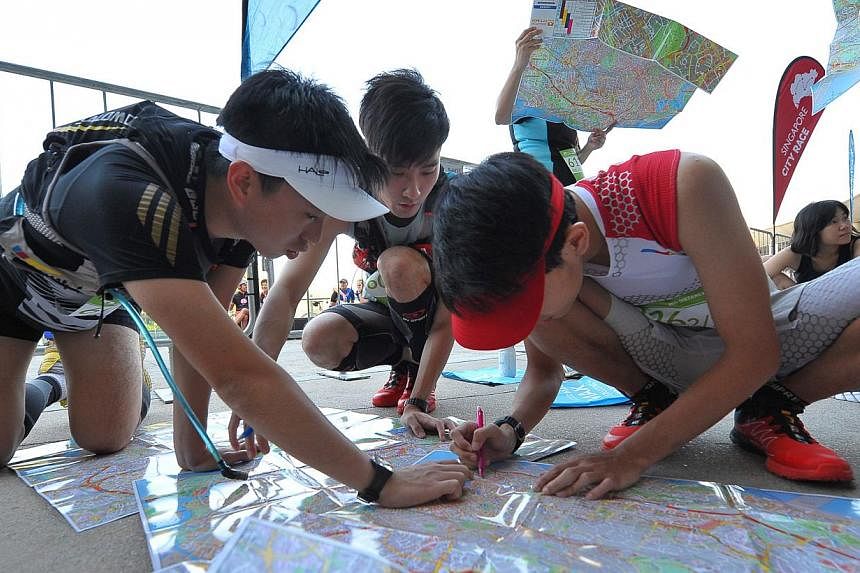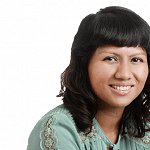After chalking up about 15 endurance races a year for the past six years, Mr Norhalim Nordin was ready for a change of scenery.
Together with five buddies, the 29-year-old supply chain coordinator signed up for the Nathan Singapore City Race in March, his first free-form race.
The 45km event has no fixed route. Instead, participants have to clear five checkpoints scattered across the island in the shortest time on foot, using a map.
"Free-form races get you to explore places you've rarely been to, instead of the similar routes where half and full marathons are always held," he says.
Without a set route or signs to guide them, participants have to plan the quickest way to get to the checkpoints pre-marked on a physical map, which may sometimes come with clues. These races are usually competitive and prizes, which include cash or products, are awarded to those who finish first.
Mr Norhalim, whose group took eight hours to complete the race and came in 10th out of 137 teams, likens the experience to a treasure hunt with time pressure. Others might dub it Amazing Race, after the popular American reality TV series.
The technical term for this activity is "orienteering". It involves navigating an unknown area to look for clues or checkpoints. Participants use a map and sometimes a compass, to find their way around on foot.
This may be familiar ground for those who have served in the army or were scouts or girl guides in school, but the activity is also becoming popular among the masses. At least six races organised here this year contain some element of orienteering. Two of them - Nathan Singapore City Race and Ubin Wayfinder - revolve solely around navigational skills and made their debut last year.
The Nathan Singapore City Race, which drew about 3,500 participants last year, saw 4,000 people this year. Organised by sports event organiser Pink Apple, the race has multiple categories with distances that range from 5 to 45km. Each route features five checkpoints which the organiser describes as "hidden treasures", such as a portcullis (a vertical iron gate) at Labrador Park and Sri Thendayuthapani Temple in Tank Road.
Ubin Wayfinder, a similar race on a smaller scale, takes place tomorrow at Pulau Ubin. Held by outdoor sports events company Osportz, it will flag off with about 160 racers, up from about 120 last year, and will cover 8km and 10 checkpoints.
Both races can be done solo or in groups.
While conventional races test stamina, orienteering races require map-reading skills, a good sense of direction and, in the case of group challenges, communication skills.
The level of technical skill can differ from race to race. For example, maps might suffice for some but others might require a compass.
The lack of signage, recognisable landmarks and spotty cellphone networks add to the level of difficulty for the participants of Ubin Wayfinder. Checkpoints for the race have names such as Knoll- North/Fallen Tree, Quarry View or simply Trail.
For those used to relying on GPS, having to read physical maps and compasses can be a big hurdle.
Teacher Ana Wong says with a laugh: "It will be challenging. I'm totally new to Pulau Ubin. Maybe I should read up on how to use the compass." The 33-year-old is taking part in Ubin Wayfinder, her first free-form race, with a friend she met while attending an orienteering session.
Some existing adventure races also include elements of orienteering, among other things.
For example, the annual Safra Avventura race held in January had a section in the 50km Ultra category that saw participants navigating only with a map through Simpang, a swampy area near Yishun.
Students at Republic Polytechnic are organising a multi-disciplinary race that is about 9km long which incorporates navigational challenges. The race, Avontuur de Republic, takes place next Friday and is open only to its students, alumni and staff.
Student Nelson Chua, 18, one of the organisers, says: "Some aspects of orienteering may be quite dry, especially the theoretical parts. But once people find themselves getting a bit lost, that's when it gets exciting."
But exciting is probably not how Mr Sanjay Radakrishna would describe his real-life predicament when he got lost while trekking alone at Phnom Aural, the tallest mountain in Cambodia, in June. The 26-year-old National Institute of Education undergraduate made the headlines, surviving only on water for a week after a fall led him to lose his way. The trek was supposed to take just two to three hours.
With a dead mobile phone and no GPS, he followed a waterfall trail and used the position of the sun as a gauge of direction to find his way back to civilisation.
Mr Sanjay, who has taken part in a few orienteering races previously, said his brain kicked into high gear to look for clues to help him identify which way to go. "When you are lost, your brain works differently. I realised there are always some clues to help you. For example, if you see rubbish on the ground, you will know that someone had been there," he says, adding that that was how he knew he was close to civilisation. He says he now takes along food, a waterproof jacket and, if available, a physical map, no matter how short his climbs are expected to be. He has done 49 climbs since 2003 and will be leading a group of climbers up Mount Rinjani on Indonesia's Lombok island next month.
For those keen to equip themselves with such essential life skills, there are courses and sessions on the basics of orienteering.
For example, a group of enthusiasts who formed the Orienteering Federation of Singapore last year conduct orienteering activities in parks around Singapore for free.
The sessions, which take place about once a month, are organised using Meetup, an online social networking portal. The Singapore Orienteering Meetup Club has 125 members and about 10 people attend each session on average.
Mr Fish Tan, 26, the federation's vice-president who organises the sessions, says: "Some people have the impression that it is a fast-paced sport. But it's a sport that everybody can do. Old people can slowly complete the route."
Young children can also pick up life skills from orienteering. The People's Association has organised two such family-friendly events this year - at Bishan Park and the Japanese Garden.No other orienteering sessions are planned, but a spokesman says it might offer more if there is interest.
Travel consultant Gayathri Shankar, 36, who attended the session at Bishan Park with her six-year-old son Gaurav Panicker, found it a fruitful experience. "He learnt a lot, such as teamwork, how to read and understand instructions and how you need to follow a system," she says.
They took about an hour to cover more than 30 checkpoints and she may just have a little cartographer on her hands now. She adds: "We are addicted to maps now. We go to the zoo and he has to get the map first."




